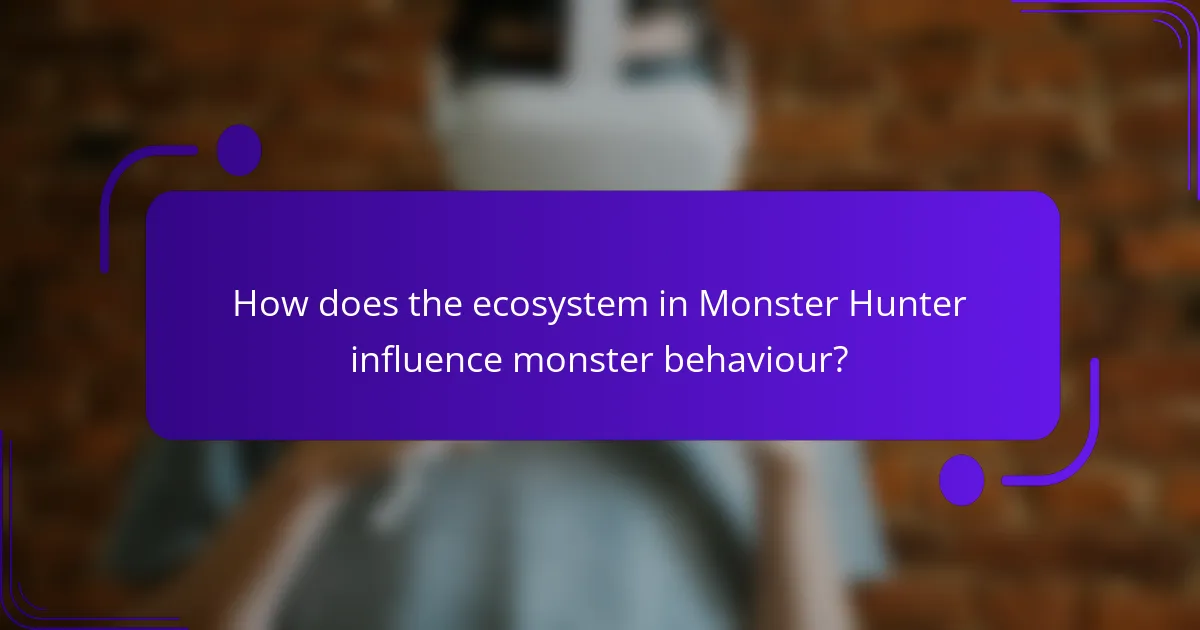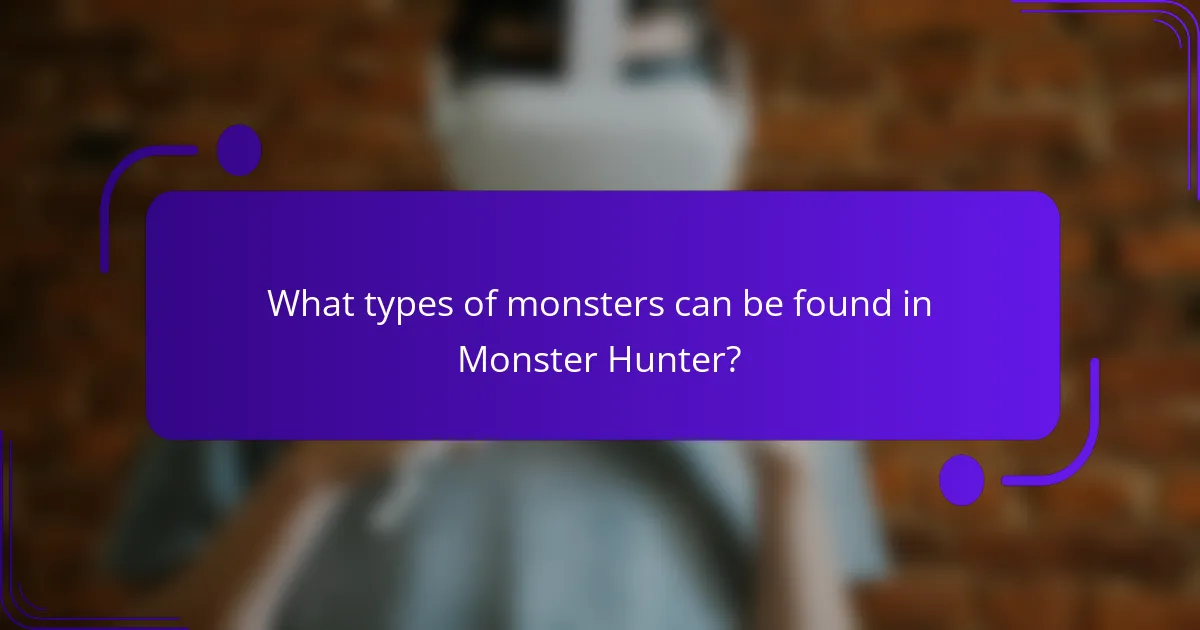Understanding the ecosystem in Monster Hunter is crucial for mastering monster behaviour and enhancing cooperative play. Explore how different environments shape monster types and interactions. Learn about the unique traits of large monsters, small monsters, and elder dragons. Discover strategies for effective teamwork that leverage environmental advantages and role specialisation.

How does the ecosystem in Monster Hunter influence monster behaviour?
The ecosystem in Monster Hunter significantly influences monster behaviour by dictating their interactions, habitats, and feeding patterns. Different environments provide unique resources that attract specific monster types. For example, monsters in lush areas exhibit territorial behaviour, while those in arid regions may be more solitary.
The presence of other monsters affects aggression levels and hunting strategies. Predatory monsters may pursue weaker prey, while herbivores tend to flee from threats. Seasonal changes in the ecosystem also impact monster activities, such as migration or mating behaviours.
In cooperative play, understanding these dynamics enhances team strategies. Players can exploit environmental advantages, such as luring monsters into traps or using terrain for ambushes. This knowledge fosters better collaboration and increases the chances of successful hunts.
What are the key components of the Monster Hunter ecosystem?
The Monster Hunter ecosystem comprises diverse monster types, environmental interactions, and cooperative play mechanics. Key components include large monsters, smaller creatures, and unique habitats. Each monster type presents distinct challenges and rewards, fostering teamwork among players. Environmental factors, such as weather and terrain, influence gameplay dynamics, enhancing the immersive experience.
How do environmental factors affect monster encounters?
Environmental factors significantly influence monster encounters in Monster Hunter. Weather conditions, terrain types, and time of day impact monster behaviour and availability. For instance, certain monsters may emerge only during specific weather events, such as rain or snow. Additionally, the ecosystem’s flora and fauna can affect monster interactions, as some creatures may prey on or compete with others. Understanding these dynamics enhances cooperative play strategies, allowing hunters to exploit environmental advantages for successful encounters.
Which ecosystems are most prevalent in Monster Hunter games?
The most prevalent ecosystems in Monster Hunter games include forests, deserts, swamps, and tundras. Each ecosystem hosts unique monster types and environmental challenges. Forests often feature lush vegetation and diverse wildlife, while deserts present arid conditions with hardy monsters. Swamps are characterised by murky waters and ambush predators. Tundras showcase icy landscapes and resilient creatures, enhancing the cooperative play experience through varied strategies.

What types of monsters can be found in Monster Hunter?
Monster Hunter features various types of monsters, each categorized by unique traits. These include large monsters, small monsters, and elder dragons, which exhibit distinct behaviours and abilities. Large monsters often serve as primary targets for hunts, showcasing powerful attacks and complex ecosystems. Small monsters provide resources and can affect gameplay dynamics. Elder dragons represent rare, formidable foes with unique attributes that challenge hunters. Each type contributes to the game’s rich ecosystem and cooperative play experience.
How are monsters categorized by their elemental attributes?
Monsters in Monster Hunter are categorized by elemental attributes such as fire, water, thunder, ice, and dragon. Each elemental type influences a monster’s strengths and weaknesses in combat. For instance, fire-element monsters are often vulnerable to water attacks. Additionally, some monsters may possess unique elemental combinations, enhancing their combat strategies. Understanding these elemental attributes is crucial for effective hunting and cooperative play.
What are the most iconic monsters in the franchise?
The most iconic monsters in the Monster Hunter franchise include Rathalos, Diablos, and Nergigante. Rathalos is known for its aerial combat and fiery breath. Diablos features powerful charges and underground ambushes. Nergigante, a unique Elder Dragon, is recognised for its aggressive behaviour and regenerative abilities. Each monster showcases distinct attributes that contribute to the game’s rich ecosystem and cooperative play dynamics.
Which monsters are exclusive to specific regions or titles?
Certain monsters in the Monster Hunter franchise are exclusive to specific regions or titles. For example, the Great Jagras is found in Monster Hunter: World, while the Nergigante is also exclusive to that title. In contrast, the Barroth is present in both Monster Hunter: Generations and Monster Hunter: World, illustrating how certain monsters can be region-specific or title-specific. This exclusivity enhances gameplay diversity and encourages exploration across different titles.

How does cooperative play enhance the Monster Hunter experience?
Cooperative play significantly enhances the Monster Hunter experience by fostering teamwork, strategy, and shared accomplishments. Players can combine their unique abilities to tackle challenging monsters more effectively. This collaboration leads to a richer gameplay experience, as players must communicate and coordinate their actions. Additionally, cooperative play encourages players to explore diverse monster types and ecosystems together, deepening their understanding of the game’s mechanics and lore. Ultimately, the social aspect of hunting with friends creates memorable moments and enhances player engagement.
What are the benefits of hunting in a team?
Hunting in a team enhances efficiency, safety, and enjoyment. Collaborative strategies allow hunters to tackle larger monsters and share resources effectively. Teamwork fosters communication, improving coordination during hunts. Additionally, shared experiences strengthen bonds among players, creating a more engaging gameplay environment.
How do different roles contribute to successful hunts?
Different roles enhance successful hunts by leveraging unique skills and strategies. Each role, such as attacker, support, or tank, contributes to a balanced team dynamic. Attackers focus on dealing damage, maximising output against monsters. Support roles provide healing and buffs, ensuring team resilience. Tanks absorb damage, protecting vulnerable teammates. This synergy allows for efficient monster management and resource utilisation, ultimately leading to successful hunts.
What strategies can improve teamwork during hunts?
Effective strategies to improve teamwork during hunts include clear communication, role specialisation, and coordinated attacks. Establishing a shared strategy enhances collaboration and efficiency. Players should define their roles based on monster types and individual strengths. For example, a tank can absorb damage while damage dealers focus on offence. Regularly updating strategies based on monster behaviour fosters adaptability. Additionally, utilising in-game tools like the map and markers aids in coordination, ensuring all team members are aligned during hunts.

Which unique mechanics are introduced in Monster Hunter cooperative play?
Monster Hunter cooperative play introduces unique mechanics that enhance teamwork and strategy. Players can utilise synergy through specialised roles, such as tanking, damage dealing, or support, which allows for diverse combat styles. The game features a shared health pool mechanic, where players can revive each other, promoting collaboration. Additionally, cooperative play encourages the use of unique hunter arts, which provide powerful abilities that can be combined for greater effect. These mechanics foster a dynamic gameplay experience, making cooperation essential for overcoming challenging monsters.
How do synergy skills work in multiplayer settings?
Synergy skills in multiplayer settings enhance cooperative play by allowing players to combine their abilities for greater effectiveness. Players can coordinate attacks, share resources, and create powerful combos that can defeat tougher monsters. This cooperation often leads to improved efficiency during hunts, as players can cover each other’s weaknesses and amplify strengths. For example, a support character can boost an attacker’s damage, while the attacker distracts the monster. This dynamic fosters teamwork and strategy, enhancing the overall gaming experience in “Monster Hunter.”
What are the most effective communication methods among players?
Effective communication methods among players in Monster Hunter include voice chat, in-game signals, and text messaging. Voice chat allows for real-time coordination, enhancing teamwork during hunts. In-game signals, such as emotes and pings, provide quick visual cues without disrupting gameplay. Text messaging serves as a supplementary method for sharing strategies or tips between hunts. Each method supports cooperative play, fostering a strong ecosystem among players.

How can players optimize their hunting strategies in Monster Hunter?
Players can optimize their hunting strategies in Monster Hunter by understanding monster behaviours, utilising environmental features, and coordinating with teammates. Analysing monster types, such as large or small, helps tailor weapon choices and tactics. Utilising traps and environmental hazards increases efficiency in battles. Cooperative play enhances strategy through role specialisation, allowing players to support each other effectively. Communication is essential for executing complex strategies, ensuring all players are aligned on objectives and tactics.
What are the best practices for preparing for a hunt?
To prepare for a hunt in “Monster Hunter,” focus on gear selection, understanding monster behaviours, and coordinating with teammates.
First, equip appropriate weapons and armour that suit the monster type you will face. Analyse the monster’s weaknesses and tailor your loadout accordingly.
Next, study the ecosystem of the hunting area. Familiarise yourself with environmental features, resource locations, and monster patterns.
Lastly, communicate effectively with your team to strategise roles and tactics. Cooperative play enhances efficiency and increases the chances of a successful hunt.
Which common mistakes should players avoid during cooperative play?
Players should avoid common mistakes like poor communication, lack of coordination, ignoring monster behaviour, and not utilising team roles effectively. These errors can hinder success in cooperative play.
Effective communication is crucial; players must share information about monster locations and strategies. Coordination ensures that team members can execute plans seamlessly, such as timing attacks or healing. Understanding monster behaviour helps players anticipate actions, allowing for better positioning and dodging.
Additionally, players should embrace their unique roles, such as damage dealers, support, or tanks. By leveraging these roles, teams can enhance their overall effectiveness in hunts, leading to successful outcomes.
How can players adapt their strategies based on monster types and ecosystems?
Players can adapt their strategies by understanding monster types and their ecosystems. Each monster type has unique behaviours and weaknesses influenced by its environment. For example, aquatic monsters may require players to utilise water-based attacks, while forest-dwelling monsters might be vulnerable to fire.
Cooperative play enhances strategy adaptation; players can specialise in roles that counter specific monster attributes. For instance, a player focusing on healing can support a frontline attacker, allowing for a balanced approach.
Additionally, players should observe ecosystem interactions, as some monsters may assist or hinder others. Understanding these dynamics can lead to effective ambush strategies or avoidance tactics.
Adaptation also involves gear selection; equipping armour and weapons that exploit specific monster weaknesses can significantly improve success rates in hunts.